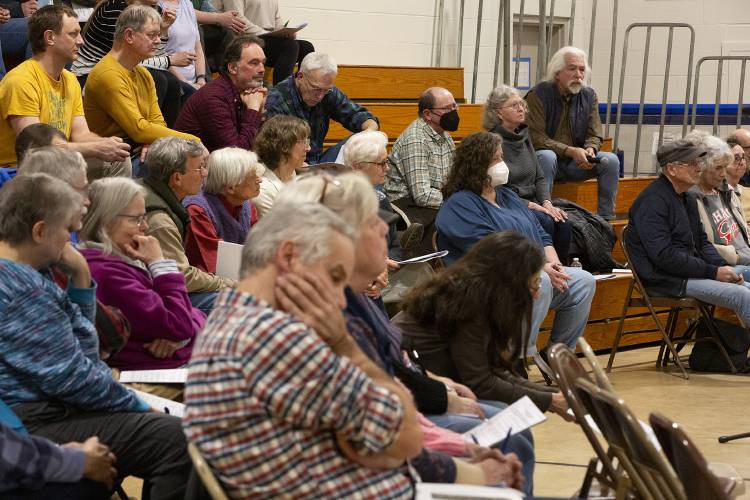Editorial: How Vermont can simplify its school funding system

Joyce Dion, left, and George Ostler, center, rest their heads in their hands while listening to the board’s response to a question about last year’s budget surplus asked by Alex Bird, top right, during the Annual School Meeting at Sharon Elementary School in Sharon, Vt., on Monday, March 4, 2024. Following changes to Act 127, the school board moved to amend their proposed budget from the floor, eliminating a $475,000 one-time expenditure. (Valley News / Report For America - Alex Driehaus) Copyright Valley News. May not be reprinted or used online without permission. Send requests to permission@vnews.com. Alex Driehaus
|
Published: 03-08-2024 9:21 PM
Modified: 03-11-2024 10:31 AM |
Last week in this space, we revisited the origins of Vermont’s school funding system in the context of panic-inducing predictions of sky-high school budgets and tax rates for next year. How that will play out is not yet clear, but the uncertainty has some lawmakers thinking about fundamental changes. We promised to provide our thoughts on that score; we do so today with abundant humility given the highly technical nature of the subject.
As we noted, the Vermont Supreme Court’s 1997 decision in the Brigham case declared that all Vermont school children are constitutionally entitled to substantially equal educational opportunity and that the state is responsible for providing it. The court also invalidated the then-existing system of school finance, which depended heavily on local property taxes supplemented by some state aid, because property-wealthy towns had a far easier time raising money than property-poor ones. Devising a new system was left to the Legislature, without any mandate as to how the money should be raised.
The replacement, Act 60 and its successors, has been generally successful in ensuring equal educational opportunity. But there are issues that we think the Legislature needs to address, even though the current version, Act 127, is still being phased in. They include the system’s complexity; its lack of effective cost controls; and a disconnect between spending decisions and the primary responsibility to pay for them.
The state’s Education Fund consists mainly of the aggregate of all local school spending decisions in a given year. The Legislature must then fund that amount, whatever it turns out to be. This is done by setting tax rates on homestead property (a primary dwelling and surrounding land); and non-homestead property, such as commercial and industrial, rental, second homes etc. Together these property taxes account for about 65% of needed revenue, with the Legislature applying other sources of tax revenue to make up the difference.
This raises a significant question: If the state is responsible for funding the system, shouldn’t it have a decisive say in how much is spent in total? We think it should, although we are mindful that the tradition of local control is deeply embedded in Vermont’s political culture.
The need to get a better handle on spending was made manifest in this year’s school budget cycle, which threatens to result in massive tax rate increases. But even before that, according to the Legislature’s Joint Fiscal Office, Vermont ranked second in the nation in per-pupil spending at $23,299 for the 2020-2021 school year; it had more staff per pupil than any other state; and had the second lowest pupil-to-teacher ratio. A contributing factor is that Vermont has many small schools that require minimum staffing levels even as pupil enrollment declines, but the fact remains that spending is high.
It’s very clear to us that at the very least the state needs to reimpose a measure known as “the excess spending adjustment,” which has been suspended since the beginning of the pandemic. This is a mechanism intended to discourage a school district from spending significantly more than others by increasing that district’s tax rate if it exceeds a specified threshold. But many other cost control mechanisms are employed by other states, including spending caps for specific services and for staffing ratios. The Legislature should explore them.
A key weakness of the current system is its complexity and the difficulty of understanding how school budget votes at the local level affect residents’ tax bills. Recrafting the system to make that more apparent is essential.
Article continues after...
Yesterday's Most Read Articles
Finally, using residential property taxes as a foundational funding source for schools is an anachronism. It has long been recognized that they do not accurately reflect ability to pay. In fact the current system acknowledges this truth by granting tax adjustments to the homestead rate based on income for those who earn under a certain threshold. Nearly 70% of Vermonters are able to take advantage of this adjustment. Wouldn’t it be far more sensible and a lot more understandable simply to base residential school taxes on income and wealth? That, we think, would also help voters make the connection between budget votes and their tax bills.
So what would an improved system look like? State government would have a much bigger say in the total amount of school spending; it would include effective disincentives for districts to spend in excess of a threshold amount; the consequences of local spending decisions would be simple to understand and predictable; and it would be based straightforwardly on ability to pay. Those are our thoughts; let us and your lawmakers hear your ideas.

 Editorial: Parker parole a reminder of how violence reshapes our lives
Editorial: Parker parole a reminder of how violence reshapes our lives Editorial: Chris Sununu’s moral vacuum
Editorial: Chris Sununu’s moral vacuum Editorial: Gambling tarnishes America’s sporting life
Editorial: Gambling tarnishes America’s sporting life By the Way: A white nationalist’s many mistruths
By the Way: A white nationalist’s many mistruths
